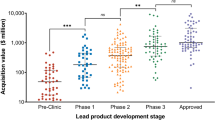Abstract
The recent volume of merger and acquisition activity in the biopharmaceutical industry has been high and is expected to accelerate in 2009 and 2010 due to global economic conditions. In order to understand changes following merger and acquisition (M&A) in clinical research investment and activity, Tufts Center for the Study of Drug Development analyzed development pipeline and spending data for 24 of the largest independent M&As occurring between 1998 and 2004 that each exceeded $1 billion in transaction value. Organizations that had experienced a merger or acquisition were evaluated across three time periods and compared with industry benchmarks: 2 years prior to an M&A announcement, and 2 years and 4 years after the transaction was announced. The results indicate that following a transaction, companies initially limit R&D spending growth to accommodate integration challenges, uncertainty, and instability. However, 4 years post-transaction M&A companies rapidly increase R&D spending across a significantly consolidated portfolio of late-stage (phase 2 and 3) development projects. Due to resource constraints and integration uncertainty, phase 1 and 3 product attrition rates for M&A companies are higher than the industry average. Statistically significant differences are observed in development pipeline and spending practices between small and large acquirers and between companies undergoing mergers versus acquisitions. The results of the study offer biopharmaceutical executives and financial professionals insights into better forecasting of drug development productivity and resource requirements following M&A transactions.
Similar content being viewed by others
References
Danzon P, Epstein A, Nicholson S. Mergers and acquisitions in the pharmaceutical and biotech industries. Managerial Decis Econ. 2007;28:307–328.
Whalen J, Winslow R. Cash-poor biotech firms cut research, seek aid. Wall Street J. October 29, 2008. Available at: https://doi.org/online.wsj.com/article/SB122523819921178005.html.
Graves S, Langowitz N. Innovative productivity and returns to scale in the pharmaceutical industry. Strategic Manage J. 1993;14:593–605.
Koenig M, Meezick E. Impact of mergers and acquisitions on research productivity within the pharmaceutical industry. Scientometrics. 2004;59(1):157–169.
Henderson L. The impact of mergers on clinical development. CenterWatch Monthly Newsletter. 2000;7(6):1–6.
The SCRIP 100. Annual SCRIP Supplement. London: Informa Healthcare; 2008:8–9. Available at: https://doi.org/www.scrip100.com.
Dimasi JA. Risks in new drug development: approval success rates for investigation drugs. Clin Pharmacol Ther. 2001;69(5):297–307.
Author information
Authors and Affiliations
Corresponding author
Additional information
The Drug Information Association is accredited by the Accreditation Council for Continuing Medical Education (ACCME) to provide continuing medical education for physicians. The Drug Information Association designates this educational activity for a maximum of I AMA PRA Category 1 Credit(s)™. Physicians should only claim credit commensurate with the extent of their participation in the activity.
If you would like to receive a statement of credit, you must review the article and complete the posttest and evaluation included on the DIA website. Participants must receive a passing score of 80% or better on the posttest in order to receive a statement of credit. To access the posttest and evaluation. please visit the DIA website at https://doi.org/www.diahome.org. select Educational Offerings. and then select Continuing Education from the dropdown menu, and the My Transcript link. This will take you to the My Transcript page where you will be prompted to sign in using your DIA username and password. Once signed in. you may select the article “Drug Development Portfolio and Spending Practices After Mergers and Acquisitions.” You will be prompted to complete the posttest and evaluation. Upon successful completion of the posttest. you will be able to download your statement of credit. If you are not a DIA customer. please contact the DIA office at mytranscript@diahome.org for a registration form. There is no fee lo receive your statement of credit.
Rights and permissions
About this article
Cite this article
Getz, K.A., Zuckerman, R., DiMasi, J.A. et al. Drug Development Portfolio and Spending Practices after Mergers and Acquisitions. Ther Innov Regul Sci 43, 493–500 (2009). https://doi.org/10.1177/009286150904300415
Received:
Accepted:
Published:
Issue Date:
DOI: https://doi.org/10.1177/009286150904300415




